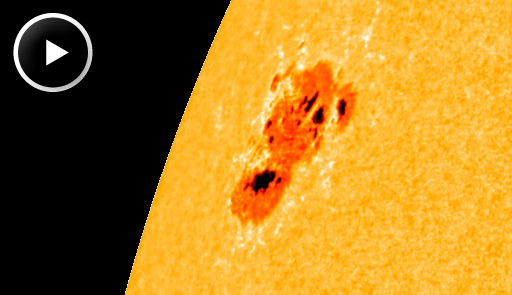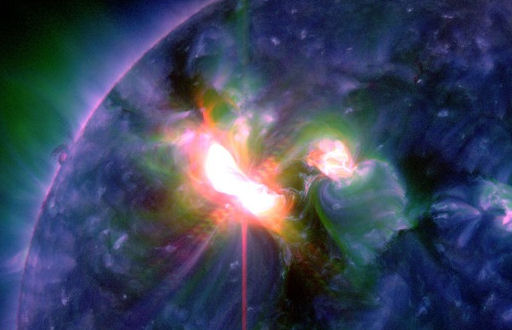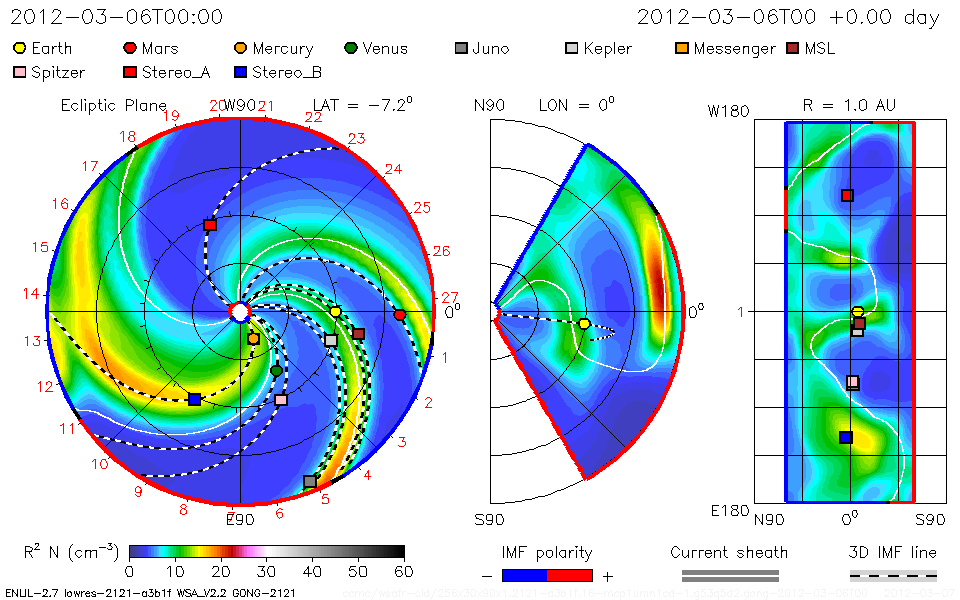WKN Weer, Klimaat en Natuurrampen
Lees alles over het onstuimige weer op onze planeet, volg orkanen en tornado's, zie hoe vulkanen uitbarsten en hoe Moeder Aarde beeft bij een aardbeving. Alles over de verwoestende kracht van onze planeet en tal van andere natuurverschijnselen.



... maar het is opeens een stuk kouder geworden na die activiteit 
Als het niet met een hamer te repareren is, is het een elektrisch probleem.


Dus dat vind ik onzin....
Want dan had na de X-28 van Oktober 2003 toch heel erg koud moeten zijn.
Want dan had na de X-28 van Oktober 2003 toch heel erg koud moeten zijn.
<a href="http://www.vwkweb.nl/" rel="nofollow" target="_blank">[b]Vereniging voor weerkunde en klimatologie[/b]</a>
<a href="http://www.estofex.org/" rel="nofollow" target="_blank">[b]ESTOFEX[/b]</a>
<a href="http://www.estofex.org/" rel="nofollow" target="_blank">[b]ESTOFEX[/b]</a>


quote:Een tornado zo groot als de aarde zelf
Een enorme tornado wervelende over het oppervlak van de Zon, onlangs vastgelegd door een NASA satelliet: een geweldig wonder van het zonnestelsel dat wellicht net zo groot als de Aarde zelf is.
Astronomen kregen een spectaculaire show op de Zon te zien, toen een "zonne-tornado" zijn weg over het oppervlak vond.
De beelden, vastgelegd gedurende een 30-uur periode door NASA's Solar Dynamics Observatory, vangen de langzaam bewegende zonnevlammen op, terwijl ze dansen over het oppervlak van de Zon.
De grote “zonne-tornado” die over de Zon blaast, op 7 en 8 februari, wordt gevormd door het magnetische veld van de ster.
"Er is een actief gebied roterend in beeld, dat een heldere achtergrond biedt voor de draaiende plasma stromen", citeerden SDO missie wetenschappers op Space.com. "De deeltjes worden op deze wijze aangetrokken, en wel door met elkaar strijdende magnetische krachten. Ze volgen de strengen van de magnetische veldlijnen."


Dat zal wel ietsje meer zijn dan een F5
<a href="http://www.vwkweb.nl/" rel="nofollow" target="_blank">[b]Vereniging voor weerkunde en klimatologie[/b]</a>
<a href="http://www.estofex.org/" rel="nofollow" target="_blank">[b]ESTOFEX[/b]</a>
<a href="http://www.estofex.org/" rel="nofollow" target="_blank">[b]ESTOFEX[/b]</a>


Spaceweatherquote:BIG SUNSPOT:
A sunspot almost four times as wide as Earth itself is rotating onto the solar disk. NASA's Solar Dynamics Observatory recorded its entrance on March 2nd and 3rd; click to view a 24-hour animation:
The sunspot has a 'beta-gamma' magnetic field that harbors energy for strong M-class solar flares. Indeed, it has already unleashed an M3-class eruption on March 2nd that created mild waves of ionization in the atmosphere over Europe.
Earth-effects could become stronger as the sunspot turns toward our planet in the days ahead. NOAA forecasters estimate a 55% chance of additional M-class flares and a 5% chance of an X-flare during the next 24 hours


<a href="http://www.vwkweb.nl/" rel="nofollow" target="_blank">[b]Vereniging voor weerkunde en klimatologie[/b]</a>
<a href="http://www.estofex.org/" rel="nofollow" target="_blank">[b]ESTOFEX[/b]</a>
<a href="http://www.estofex.org/" rel="nofollow" target="_blank">[b]ESTOFEX[/b]</a>


quote:Twee plasmawolken richting aarde
Er zetten momenteel twee van de Zon afkomstige plasmawolken koers naar de Aarde. Dat meldt de website spaceweather.com.
De eerste plasmawolk is ontstaan door een zonne-uitbarsting van de klasse M2 gisteren. Morgen rond 5u30 zou de wolk botsen met het magnetisch veld van de Aarde.
De tweede plasmawolk is het gevolg van een X1.1 uitbarsting vanochtend. Die wolk zou ons morgen of woensdag bereiken. Op noordelijke breedtegraden is er mogelijk kans op poollicht, aldus spaceweather.com.


Een X class 
"Light thinks it travels faster than anything. It doesn't. For wherever light travels it finds darkness has got there first and is waiting for it."


Ik verwacht een KP4
<a href="http://www.vwkweb.nl/" rel="nofollow" target="_blank">[b]Vereniging voor weerkunde en klimatologie[/b]</a>
<a href="http://www.estofex.org/" rel="nofollow" target="_blank">[b]ESTOFEX[/b]</a>
<a href="http://www.estofex.org/" rel="nofollow" target="_blank">[b]ESTOFEX[/b]</a>


quote:Zon blijft onrustig
Het blijft onrustig op de Zon, meer bepaald vanuit de enorme zonnevlekkkengroep 1429. Na de zeer zware uitbarsting van gisteren, ontstonden er in de voorbije 24 uur nog meerdere zware uitbarstingen, zo blijkt op gespecialiseerde websites.
Gisteren veroorzaakte een uitbarsting van de X1-klasse opschudding bij waarnemers van het ruimteweer. Nadien volgde nog een vijftal uitbarstingen van de lagere M-klasse. De laatste was vannacht om 02.52 uur Belgische tijd, van de klasse M1.26, zo heeft poollicht.be getwitterd.
Sander Vancanneyt van de gespecialiseerde website SpaceWeatherLive.com zegt dat zonnevlekkengroep 1429 gisteren nog is aangegroeid en dat de complexiteit groot is. Hij sluit een nieuwe zware uitbarsting, mogelijk van de X-klasse, niet uit.


Spaceweatherquote:CHANCE OF FLARES: Today, NOAA forecasters estimate a 75% chance of M-class solar flares and a 30% chance of an X-flare from big sunspot AR1429.The active region is slowly turning to face Earth, so if any such eruptions do occur, they are increasingly likely to be geoeffective.


Spaceweatherquote:MAJOR SOLAR FLARE: Big sunspot AR1429 has unleashed another major flare. This one is the strongest yet, an X5-class eruption on March 7th at 00:28 UT. NASA's Solar Dynamics Observatory recorded the extreme UV flash:
This eruption hurled a bright CME into space. First-look data from STEREO-B are not sufficient to determine if the cloud is heading for Earth. Our best guess is "probably, yes, but not directly toward Earth." A glancing blow to our planet's magnetosphere is possible on March 8th or 9th. Stay tuned for updates.


Jammer dat het zo bewolkt is de komende dagen. Volgende week is er lente weer en veel minder bewolking!


Het zal toch wel harder dan een X5 moeten (en ze weten nog niet eens of die wel onze kant uit komt) wil je hier iets van noorderlicht kunnen zien?
"Light thinks it travels faster than anything. It doesn't. For wherever light travels it finds darkness has got there first and is waiting for it."


Heeft met allerlei omstandigheden te maken natuurlijk, maar vorig jaar was er in NL wel wat te zien geloof ik, en kan me herinneren dat dat een X-2 was. Achter die X 5 komt een X1.8 ofzo aan begreep ik, door de zonnevlek vlak naast 1429.


Een x5 das nogal wat. Spannend. Vorig jaar was er een x8.7 ofzo die niet earth directed was dacht ik.


Als de wind maar zuidelijk staatquote:Op woensdag 7 maart 2012 16:25 schreef Frutsel het volgende:
Een x5 das nogal wat. Spannend. Vorig jaar was er een x8.7 ofzo die niet earth directed was dacht ik.
Kans op Poollicht de komende 3 dagen
8 mrt: behoorlijke kans op noorderlicht
9 mrt: behoorlijke kans
10 mrt: kleine kans
http://www.poollicht.info/
En hou http://chat.poollicht.nl/ in de gaten.
Als er wat aan de hand is wordt het druj op de chat
<a href="http://www.vwkweb.nl/" rel="nofollow" target="_blank">[b]Vereniging voor weerkunde en klimatologie[/b]</a>
<a href="http://www.estofex.org/" rel="nofollow" target="_blank">[b]ESTOFEX[/b]</a>
<a href="http://www.estofex.org/" rel="nofollow" target="_blank">[b]ESTOFEX[/b]</a>


<a href="http://www.vwkweb.nl/" rel="nofollow" target="_blank">[b]Vereniging voor weerkunde en klimatologie[/b]</a>
<a href="http://www.estofex.org/" rel="nofollow" target="_blank">[b]ESTOFEX[/b]</a>
<a href="http://www.estofex.org/" rel="nofollow" target="_blank">[b]ESTOFEX[/b]</a>


Het is mooi helder buiten, hopen dat dat morgen ook zo is. 
Free Assange! Hack the Planet
[b]Op dinsdag 6 januari 2009 19:59 schreef Papierversnipperaar het volgende:[/b]
De gevolgen van de argumenten van de anti-rook maffia
[b]Op dinsdag 6 januari 2009 19:59 schreef Papierversnipperaar het volgende:[/b]
De gevolgen van de argumenten van de anti-rook maffia


ik heb hulp nodig! zit in australie, weet iemand wanneer ik wat kan zien van het poollicht? heb nog nooit zoiets gezien en zou het heel graag willen zien! 
een kromme plank is niet recht


Is er al iets gebeurd van betekenis? qua storingen of iets? of komt dat nog...
[b]Hobbelicious is back!
[/b]
[/b]


Als het donker word naar het zuiden kijken de komende 2 nachten.quote:Op donderdag 8 maart 2012 11:52 schreef PlankHout het volgende:
ik heb hulp nodig! zit in australie, weet iemand wanneer ik wat kan zien van het poollicht? heb nog nooit zoiets gezien en zou het heel graag willen zien!
Free Assange! Hack the Planet
[b]Op dinsdag 6 januari 2009 19:59 schreef Papierversnipperaar het volgende:[/b]
De gevolgen van de argumenten van de anti-rook maffia
[b]Op dinsdag 6 januari 2009 19:59 schreef Papierversnipperaar het volgende:[/b]
De gevolgen van de argumenten van de anti-rook maffia


Mi..j..n..p..c..h.a..n.g..t...a....l..e....e...n.......b.e...e...t...j.e...quote:Op donderdag 8 maart 2012 12:49 schreef MissHobje het volgende:
Is er al iets gebeurd van betekenis? qua storingen of iets? of komt dat nog...


quote:Op donderdag 8 maart 2012 13:01 schreef RolStaart-Beer het volgende:
[..]
Mi..j..n..p..c..h.a..n.g..t...a....l..e....e...n.......b.e...e...t...j.e...
[b]Hobbelicious is back!
[/b]
[/b]


<a href="http://www.vwkweb.nl/" rel="nofollow" target="_blank">[b]Vereniging voor weerkunde en klimatologie[/b]</a>
<a href="http://www.estofex.org/" rel="nofollow" target="_blank">[b]ESTOFEX[/b]</a>
<a href="http://www.estofex.org/" rel="nofollow" target="_blank">[b]ESTOFEX[/b]</a>


Er valt nog niets te zien.
SPOILEROm spoilers te kunnen lezen moet je zijn ingelogd. Je moet je daarvoor eerst gratis Registreren. Ook kun je spoilers niet lezen als je een ban hebt.Free Assange! Hack the Planet
[b]Op dinsdag 6 januari 2009 19:59 schreef Papierversnipperaar het volgende:[/b]
De gevolgen van de argumenten van de anti-rook maffia


Als het zo doorgaat 
<a href="http://www.vwkweb.nl/" rel="nofollow" target="_blank">[b]Vereniging voor weerkunde en klimatologie[/b]</a>
<a href="http://www.estofex.org/" rel="nofollow" target="_blank">[b]ESTOFEX[/b]</a>
<a href="http://www.estofex.org/" rel="nofollow" target="_blank">[b]ESTOFEX[/b]</a>


Misschien in het Noorden..quote:Op donderdag 8 maart 2012 23:06 schreef Maver24 het volgende:
Is er nu kans vanavond om wat te zien ???,
[b]Hobbelicious is back!
[/b]
[/b]


Kan dat ook invloed hebben op het weer eigenlijk?
Never Stop Exploring!
Life begins at the end of your comfort zone!
Follow me on Twitter: https://twitter.com/EdwinKr83 Instagram: https://www.instagram.com/edwinkr83/
Life begins at the end of your comfort zone!
Follow me on Twitter: https://twitter.com/EdwinKr83 Instagram: https://www.instagram.com/edwinkr83/


Spaceweather:
quote:Space Weather Message Code: WARK07
Serial Number: 34
Issue Time: 2012 Mar 09 0658 UTC
WARNING: Geomagnetic K-index of 7 or greater expected
Valid From: 2012 Mar 09 0700 UTC
Valid To: 2012 Mar 09 0900 UTC
Warning Condition: Onset
NOAA Scale: G3 or greater - Strong to Extreme
NOAA Space Weather Scale descriptions can be found at www.swpc.noaa.gov/NOAAscales
Potential Impacts: Area of impact primarily poleward of 50 degrees Geomagnetic Latitude. Induced Currents - Power system voltage irregularities possible, false alarms may be triggered on some protection devices.
Spacecraft - Systems may experience surface charging; increased drag on low Earth-orbit satellites and orientation problems may occur.
Navigation - Intermittent satellite navigation (GPS) problems, including loss-of-lock and increased range error may occur.
Radio - HF (high frequency) radio may be intermittent.


10 uur 's ochtends volgens mij (UTC+1 in de winter)quote:
And what rough beast, its hour come round at last,
Slouches towards Bethlehem to be born?
Slouches towards Bethlehem to be born?


Laat maar komen die KP7
Maar wel als het onbewolkt is en minder vocht in de lucht
Maar wel als het onbewolkt is en minder vocht in de lucht
<a href="http://www.vwkweb.nl/" rel="nofollow" target="_blank">[b]Vereniging voor weerkunde en klimatologie[/b]</a>
<a href="http://www.estofex.org/" rel="nofollow" target="_blank">[b]ESTOFEX[/b]</a>
<a href="http://www.estofex.org/" rel="nofollow" target="_blank">[b]ESTOFEX[/b]</a>


En donker, want om 10.00 is het allang licht hier in Nederland :p
"Light thinks it travels faster than anything. It doesn't. For wherever light travels it finds darkness has got there first and is waiting for it."


Poollicht misschien te zien bij
heldere donkere hemel! Groen poollicht
tot ca. 10° boven noordelijke horizon.
Daarboven is rood/violet mogelijk
heldere donkere hemel! Groen poollicht
tot ca. 10° boven noordelijke horizon.
Daarboven is rood/violet mogelijk
<a href="http://www.vwkweb.nl/" rel="nofollow" target="_blank">[b]Vereniging voor weerkunde en klimatologie[/b]</a>
<a href="http://www.estofex.org/" rel="nofollow" target="_blank">[b]ESTOFEX[/b]</a>
<a href="http://www.estofex.org/" rel="nofollow" target="_blank">[b]ESTOFEX[/b]</a>


Het hoost vreselijk hard, weer niets te zien.quote:Op zaterdag 10 maart 2012 02:40 schreef -CRASH- het volgende:
Poollicht misschien te zien bij
heldere donkere hemel! Groen poollicht
tot ca. 10° boven noordelijke horizon.
Daarboven is rood/violet mogelijk
[b]Hobbelicious is back!
[/b]
[/b]


Mijn wekker doet het ook nog, mislukte flare 
Free Assange! Hack the Planet
[b]Op dinsdag 6 januari 2009 19:59 schreef Papierversnipperaar het volgende:[/b]
De gevolgen van de argumenten van de anti-rook maffia
[b]Op dinsdag 6 januari 2009 19:59 schreef Papierversnipperaar het volgende:[/b]
De gevolgen van de argumenten van de anti-rook maffia


WEEKEND SOLAR FLARE:
Sunspot AR1429 is still erupting this weekend. On Saturday, March 10th, it produced a powerful M8-class flare that almost crossed the threshold into X-territory. In New Mexico, amateur radio astronomer Thomas Ashcraft recorded a series of shortwave bursts emanating from the blast site: audio. Also, the explosion propelled yet another CME toward Earth: forecast track. The cloud is expected to hit our planet's magnetosphere on March 12th around 1800 UT. A CME from an earlier explosion will arrive much sooner, however. Continue reading.....
INCOMING CME:
A CME from sunspot AR1429 is nearing Earth. According to analysts at the Goddard Space Weather Lab, the cloud will arrive on March 11th at 0649 UT (+/- 7 hr). NOAA forecasters say the odds of a strong geomagnetic storm at that time is 50%
www.spaceweather.com
Sunspot AR1429 is still erupting this weekend. On Saturday, March 10th, it produced a powerful M8-class flare that almost crossed the threshold into X-territory. In New Mexico, amateur radio astronomer Thomas Ashcraft recorded a series of shortwave bursts emanating from the blast site: audio. Also, the explosion propelled yet another CME toward Earth: forecast track. The cloud is expected to hit our planet's magnetosphere on March 12th around 1800 UT. A CME from an earlier explosion will arrive much sooner, however. Continue reading.....
INCOMING CME:
A CME from sunspot AR1429 is nearing Earth. According to analysts at the Goddard Space Weather Lab, the cloud will arrive on March 11th at 0649 UT (+/- 7 hr). NOAA forecasters say the odds of a strong geomagnetic storm at that time is 50%
www.spaceweather.com
<a href="http://www.vwkweb.nl/" rel="nofollow" target="_blank">[b]Vereniging voor weerkunde en klimatologie[/b]</a>
<a href="http://www.estofex.org/" rel="nofollow" target="_blank">[b]ESTOFEX[/b]</a>
<a href="http://www.estofex.org/" rel="nofollow" target="_blank">[b]ESTOFEX[/b]</a>


Spaceweatherquote:Magnetic fields on the sun's northeastern limb erupted around 17:45 UT on April 16th, producing one of the most visually-spectacular explosions in years. NASA's Solar Dynamics Observatory (SDO) recorded the blast at extreme ultraviolet wavelengths:
The explosion, which registered M1.7 on the Richter Scale of solar flares, was not Earth-directed, but it did hurl a CME into space. Analysts at the Goddard Space Weather Lab have analyzed the trajectory of the cloud and found that it will hit NASA's STEREO-B spacecraft, the Spitzer space telescope, and the rover Curiosity en route to Mars. Planets Venus and Mars could also receive a glancing blow.


1) Op dit moment (22:34)
Poollicht misschien te zien bij heldere donkere hemel!
Groen poollicht tot ca. 10° boven noordelijke horizon.
Daarboven is rood/violet mogelijk.
<a href="http://www.vwkweb.nl/" rel="nofollow" target="_blank">[b]Vereniging voor weerkunde en klimatologie[/b]</a>
<a href="http://www.estofex.org/" rel="nofollow" target="_blank">[b]ESTOFEX[/b]</a>
<a href="http://www.estofex.org/" rel="nofollow" target="_blank">[b]ESTOFEX[/b]</a>


Ik zal zo kijkje nemen al wordt het lastig met de bewolking ben ik bang maar ik zal het even in de gaten houden 
Doe mee met het voorspellen van het weer!
Weekvoorspelling | Week 52 (invullen tot 22-12 - 11:59)
Maandvoorspelling December(Gesloten)
Jaarvoorspelling 2024 / 2025
Weekvoorspelling | Week 52 (invullen tot 22-12 - 11:59)
Maandvoorspelling December(Gesloten)
Jaarvoorspelling 2024 / 2025


quote:INCOMING CME
Sunspot AR1471 erupted on May 7th, producing an M1-class solar flare and an Earth-directed coronal mass ejection (CME). According to a forecast track prepared by analysts at the Goddard Space Weather lab, the cloud will reach Earth on May 9th at 13:40 UT (+/- 7 hours).


Bron: Spaceweatherquote:One of the largest sunspot groups in years rotated over the sun's northeastern limb this weekend. With a least four dark cores larger than Earth, AR1476 sprawls more than 100,000 km from end to end, and makes an easy target for backyard solar telescopes. Amateur astronomer Alan Friedman sends this picture of the behemoth from his backyard in Buffalo, NY:
"AR1476 is firecrackler," says Friedman.
Indeed, the active region is crackling with impulsive M-class solar flares. Based on the sunspot's complex 'beta-gamma' magnetic field, NOAA forecasters estimate a 75% chance of more M-flares during the next 24 hours. There is also a 10% chance of powerful X-flares.
"This one is going to be fun as it turns to face us!" predicts Friedman. He might be right
| Forum Opties | |
|---|---|
| Forumhop: | |
| Hop naar: | |













